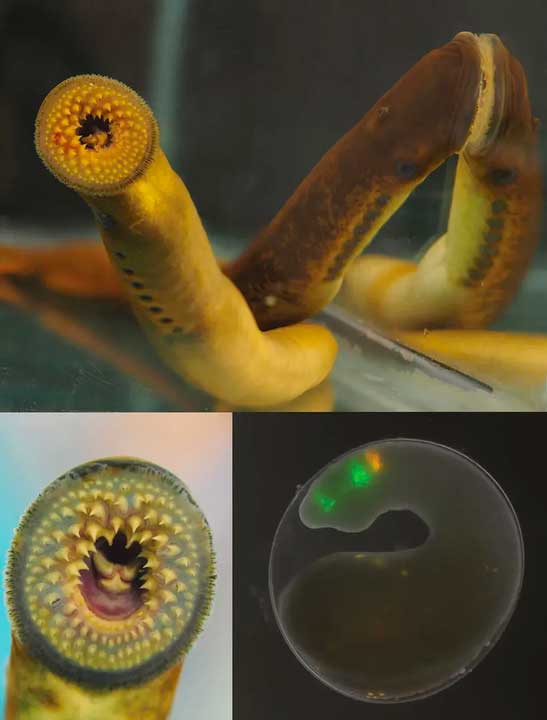As the adage goes, you can pick your friends, but you can’t pick your relatives. This even applies to your distant evolutionary cousins. In terms of a very specific genetic function, humans are a little bit more closely related to the sea lamprey than scientists once believed. According to a study published February 20 in the journal Nature Communications, we share similar hindbrains as these 500-million-year-old animals with suction-cup mouths and sharp teeth.
[Related: Giant prehistoric lamprey likely sucked blood—and ate flesh.]
What is the hindbrain?
There are three basic units of an vertebrate brain–the midbrain, forebrain, and the hindbrain. According to the National Institutes of Health, the hindbrain includes the upper part of the spinal cord, the brain stem, and the cerebellum. It controls some of the vital functions that are necessary to our survival, including blood pressure, heart rate, respiratory rhythm, motor activity, sleep, and wakefulness.
The hindbrain is an older region that has been evolutionarily conserved, or virtually unchanged throughout the process of evolution. Studying it can help evolutionary biologists peer back into the past and put together timelines for brain development and other physical features.

Sea lampreys are fish native to the Atlantic Ocean and Great Lakes. They spend about 12 to 18 months in a parasitic stage where they suck on other fish to live, before they detach. They have remained unchanged for the last 340 million years, but have a backbone and skeleton like other vertebrates. However, they are missing a jaw on their heads. Since most vertebrates have jaws, this difference in sea lampreys makes them crucial for understanding vertebrate evolution.
“There was a split at the origin of vertebrates between jawless and jawed around 500 million years ago,” study co-author and Stowers Institute for Medical Research geneticist Alice Bedois said in a statement. “We wanted to understand how the vertebrate brain evolved and if there was something unique to jawed vertebrates that was lacking in their jawless relatives.”
The role of Vitamin A
The team built on previous work that found that the genes that build and subdivide the sea lamprey hindbrain are identical to those genes in jawed vertebrates. However, these genes are part of an interconnected network–or circuit–that has to be initiated and guided on how to correctly build a hindbrain.
In the new study, the team pinpointed a common molecular cue that is part of the gene circuitry that guides the hindbrain development in sea lampreys. The cue comes from something that is probably in your daily multivitamin–retinoic acid, or vitamin A. The team already knew that retinoic acid can cue the gene circuitry to construct the hindbrain in complex species. However, it was not believed to be involved in the hindbrains for more primitive species including sea lampreys.
To their surprise, the team found that the sea lamprey core hindbrain circuit is also initiated by retinoic acid. This provides some evidence that these sucky-mouthed sea monsters and humans are much more closely related than the team anticipated.
“We found that not only are the same genes but also the same cue is involved in sea lamprey hindbrain development, suggesting this process is ancestral to all vertebrates,” said Bedois.
Common ancestry sea lampreys and humans
According to the team, understanding how the cues retinoic acid provides are used to form normal head and facial structures in vertebrates is crucial for understanding how this process can misfire. Since retinoic acid is a major player that cues vital steps in development of the brain stem, better understanding the process could help in cases where the brain stem does not develop properly in humans and other animals.
[Related: Our four-legged ancestors evolved from sea to land astonishingly quickly.]
“People thought that because sea lampreys lack a jaw, their hindbrain was not formed like other vertebrates,” study co-author and Stowers Institute for Medical Research developmental biologist Robb Krumlauf said in a statement. “We have shown that this basic part of the brain is built in exactly the same way as mice and even humans.”
If hindbrain formation is also a shared and passed on feature for all back-boned animals, other mechanisms must also be responsible to explain their incredible diversity.
“We all derived from a common ancestor,” said Bedois. “Sea lampreys have provided an additional clue. Now we need to look even further back in evolutionary time to discover when the gene circuitry governing hindbrain formation first evolved.”
Research from 2021 threw some cold water on the idea that humans and lampreys are more closely related, based on fossils of Paleozoic lamprey larvae. Either way, the enduring mystery of how closely humans and sea lamprey fit on the vertebrate family tree will continue.





